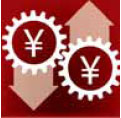 Large Medium Small
Large Medium Small5. Economic reform

China launched a 4 trillion yuan ($586 billion) economic stimulus package in late 2008 to offset the impact of the US subprime mortgage crisis.
However, relying on such investment-driven growth has resulted in the side effects of local government debt, currency mismatch and a real estate price bubble.
Faced with the continuous downturn in the real economy last year, President Xi Jinping recognized that relying on traditional economic stimulus cannot resolve the structural contradictions and may exacerbate production overcapacity. Xi resolved that the key to steady growth lies in deepening reform and structural adjustment.
Li Xuesong, deputy director of the Institute of Quantitative and Technical Economics at the Chinese Academy of Social Sciences, said China's macro-control should be placed on steady growth and that fiscal and financial reform should be prioritized to further reduce corporate tax, while reducing corporate financing costs.
The establishment of the Shanghai Free Trade Zone in September is the new government's economic reform blueprint in miniature. Implementation of the "negative list" management approval system will provide more transparency and wider opening to companies. The system only stipulates restrictions, so that companies in the zone can have more say over their operations.
The financial pilot covers cross-border and third-party payment services and management of foreign exchange, which is likely to promote the long-term internationalization of the renminbi.
The central bank announced in July that it would remove all restrictions on loan rates, and introduce a primary loan rate, opening a new chapter in rate liberalization.
Yifan Hu, chief economist at Haitong International in Hong Kong, said liberalization of interest rates is expected to raise the efficiency of the banking sector in China through the introduction of a market-oriented pricing mechanism of funding, and to further accelerate the opening-up of the financial sector by promoting more prudent and innovative risk management strategies.
Fiscal reform was also the government's key task last year. Coupled with a proactive fiscal policy and prudent monetary policy, fiscal measures were undertaken to complete a structural tax reduction policy, so that outstanding industries will obtain more supporting funds.